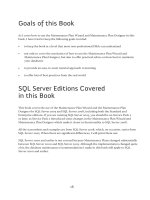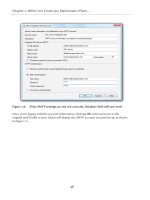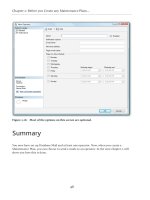Brad’s Sure Guide to SQL Server Maintenance Plans- P16 docx
Bạn đang xem bản rút gọn của tài liệu. Xem và tải ngay bản đầy đủ của tài liệu tại đây (658.49 KB, 5 trang )
Chapter 3: Getting Started with the Maintenance Plan Wizard
76
You can double-click on each job to open it up and see what it looks like. While I don't
recommend you make any changes, it is interesting to look at the command used to execute
the SSIS package for a particular scheduled task, as shown in Figure 3.21.
Figure 3.21: This screen shows how the SSIS package will be executed for this
maintenance task.
As you can see in this figure, when a scheduled job executes, all it does is execute the related
SSIS package, with a number of parameters that specify the plan to be run, the server it is to
be run on, and so on. In this particular example, Subplan_1 of the Maintenance Plan is being
run and so is passed in as a parameter.
A word of warning before we move on: while it's possible to customize your Maintenance
Plan by directly modifying its SQL Server Agent jobs, I strongly advise against it. Unless you
are an expert in both SSIS and the SQL Server Agent, the odds of "breaking" the Maintenance
Plan are very high. If you need to make any changes to a Maintenance Plan, use the
Maintenance Plan Designer. In this way, any changes will automatically be reflected in the
Maintenance Plan's related SQL Server Agent jobs.
Chapter 3: Getting Started with the Maintenance Plan Wizard
77
Likewise, if you want to delete a Maintenance Plan, be sure you do so right-clicking on the
Maintenance Plan's name and clicking Delete. If you try to delete the Maintenance Plan's
SSIS package or SQL Server Agent jobs directly, you could create a mess that will be dicult
to untangle.
Generally speaking, if you feel you need to do a lot of customization to a Maintenance Plan
once it has been created, then most likely you would be better off using T-SQL or PowerShell
scripts for your database maintenance.
Testing Your Maintenance Plan
Having created a new Maintenance Plan, and before congratulating ourselves on a job well
done and going home for the night, we should first test it to see if it runs as we expect.
To test our new Maintenance Plan, we need to run it against SQL Server, preferably during
a maintenance window so that any resources used by the plan do not interfere with user
activity. So what's the best way to test a Maintenance Plan? At first glance, this seems easy. We
can simply right-click on the plan and select Execute, as shown in Figure 3.22.
Figure 3.22: Does selecting "Execute" actually execute a Maintenance Plan?
Sounds straightforward enough but, when we select Execute, we get the error message
shown in Figure 3.23.
Chapter 3: Getting Started with the Maintenance Plan Wizard
78
Figure 3.23: Apparently, selecting "Execute" is not a good way to test a Maintenance Plan.
What does this error mean? Is our Maintenance Plan "bad?" In order to answer this question,
we can click on the Execution failed… link to find out more information about this error, as
shown in Figure 3.24
Figure 3.24: Unlike most error messages, this one is actually useful.
The error message is actually useful in this case: "User Databases Maintenance Plan contains
multiple subplans. You can execute them individually by selecting their associated jobs under the
SQL Server Agent node of Object Explorer."
In other words, the Execute option available for a Maintenance Plan will only work if a
plan has only one subplan. The topic of subplans is covered in detail in Chapter 18 but for
now, just note that a single Maintenance Plan can be made up of several subplans, and each
subplan is made up of one or more maintenance tasks. If a Maintenance Plan has more than
Chapter 3: Getting Started with the Maintenance Plan Wizard
79
one subplan (and most do), then you have to execute the individual SQL Server job for each
of the subplans in your Maintenance Plan. When creating our example Maintenance Plan
using the Wizard, behind the scenes this was actually implemented as six individual
subplans, one for each of the tasks we configured. So, in order to fully test our plan, we will
need to manually execute each of the six subplans of the Maintenance Plan in the correct
logical order.
Maintenance Task Order
As discussed in the earlier section on Maintenance Task Order, some jobs have to run
before other jobs, otherwise they might fail.
So, in order to test our new plan, we navigate to the SQL Server Agent | Jobs directory,
right-click on the relevant Maintenance Plan Job and select Start Job at Step , as shown in
Figure 3.25.
Although this name gives the impression that it might allow us to run all of the jobs, it
doesn't. Instead, once we select this option, only the job we have selected will run. Why is
this? This is because a "step" is a subset of a job, and all Maintenance Plan jobs have a single
"step." The confusion arises because "step" and "job" sound like the same thing, but they
aren't. Each job only has a single step, so we must test each job, one after another.
Having run the first job, we run the second, and so on, until they have all completed. Be sure
to only run one job at a time, and wait for it to complete successfully before trying the next.
If the databases against which the plan is running are large, then these tests can be time
consuming, so this extra time must be planned for in advance. In fact, the time it takes for a
particular task to run during testing is a valuable data point when determining when the task
should be scheduled to run.
Maintenance Task Scheduling…
…is covered in full detail in Chapter 4, where you will learn that determining the length
of a task is a very important part of creating maintenance task schedules.
Chapter 3: Getting Started with the Maintenance Plan Wizard
80
Figure 3.25: You can test each maintenance task by running Start Job at Step
While all this sounds like a somewhat laborious process, this testing is essential to ensure that
your Maintenance Plan, as a whole, will succeed. Furthermore, if a given job fails, you have
immediately narrowed your troubleshooting to the investigation of an individual job, rather
than the plan as a whole.
Let's go ahead and run the first job in our Maintenance Plan, the Check Database
Integrity job, and see what happens. Right-click on User Databases Maintenance Plan.
Subplan1, and select Start Job at Step. Hopefully, you'll see a screen similar to that shown in
Figure 3.26.









